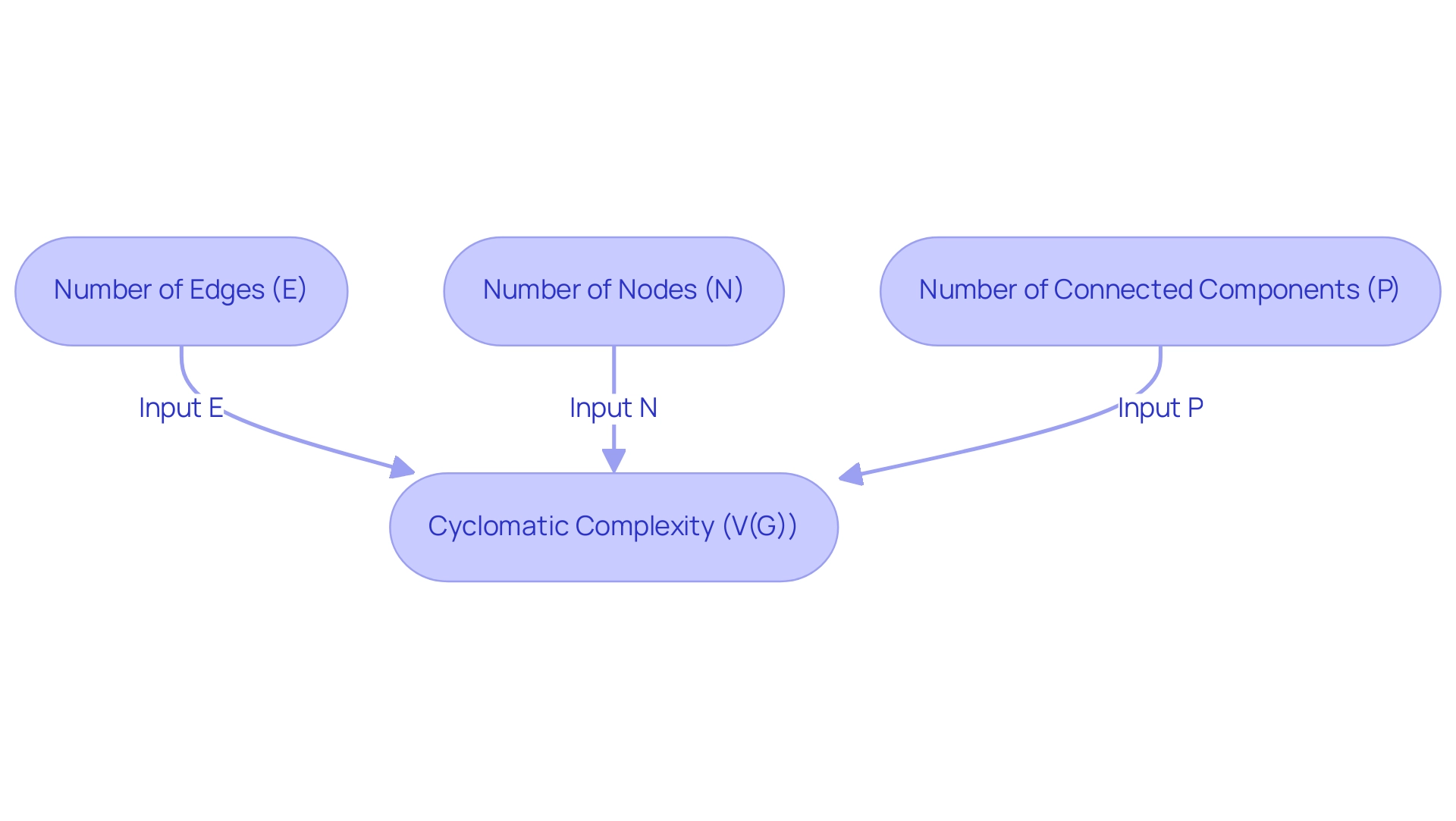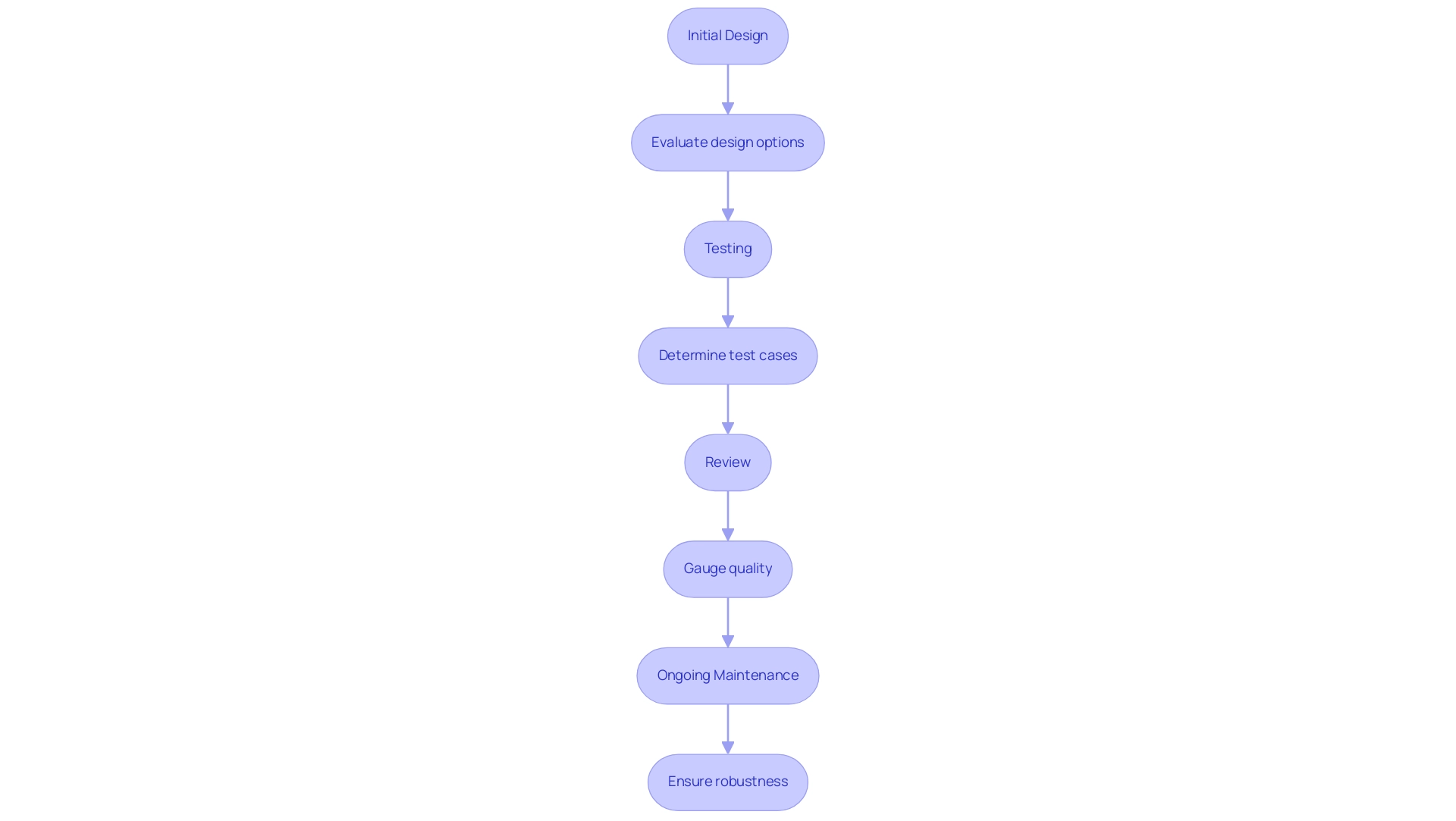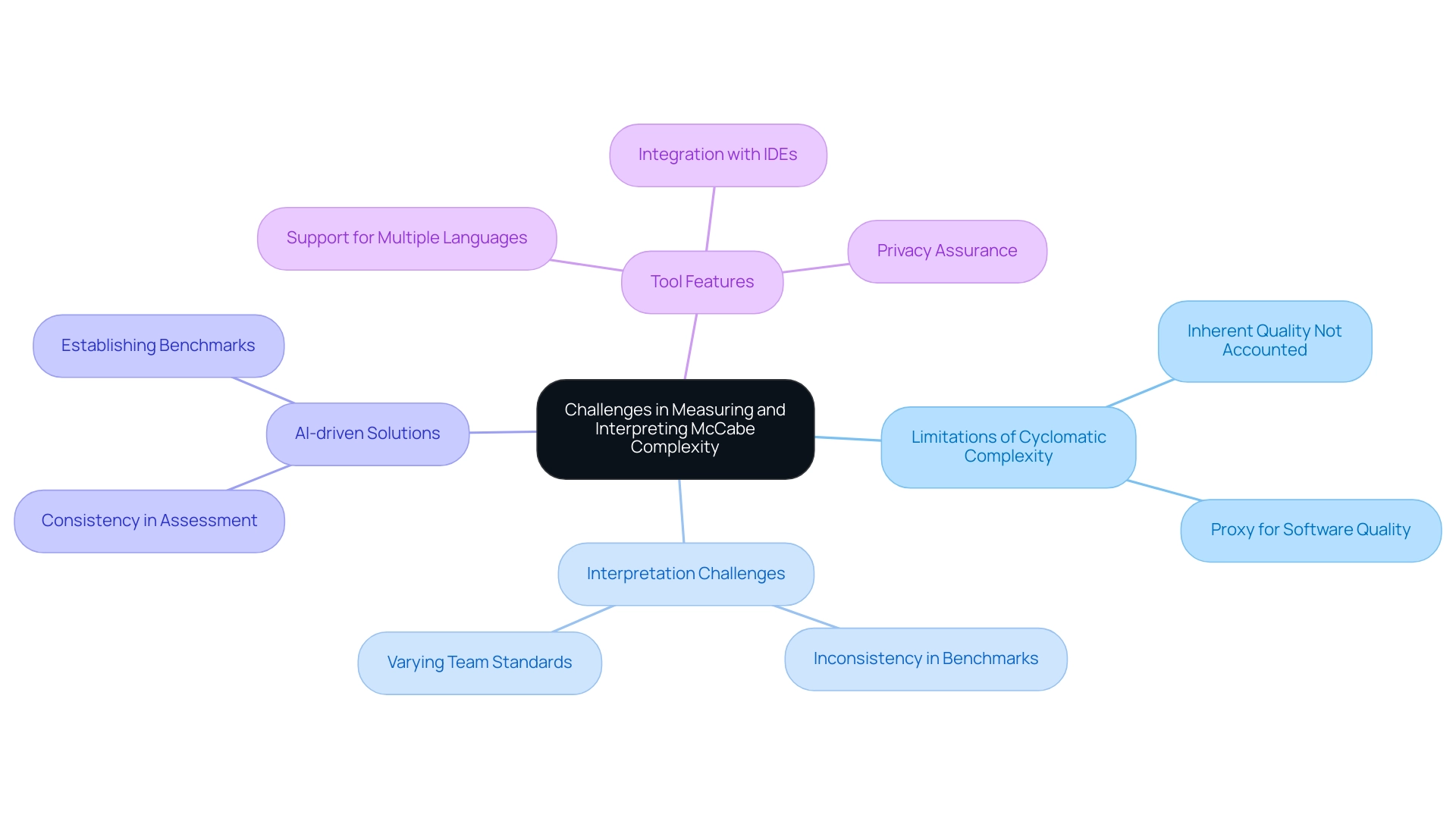Introduction
In the ever-evolving landscape of software development, understanding the intricacies of code complexity has become paramount for achieving high-quality outcomes. The McCabe Complexity Formula, widely known as Cyclomatic Complexity, serves as a crucial tool for developers, enabling them to quantify and manage the complexity of their code effectively.
By providing a clear measure of how many independent paths exist through a program, this formula not only aids in identifying potential pitfalls but also fosters better decision-making regarding code structure and maintenance. As teams strive for greater efficiency and productivity, leveraging advanced tools like Kodezi can transform the way developers approach complexity, allowing for real-time optimization and enhanced software quality.
This article delves into the significance of the McCabe Complexity Formula, its practical applications, and how integrating innovative solutions can streamline the development process, ultimately leading to superior software outcomes.
Defining the McCabe Complexity Formula: An Overview
The McCabe Measurement Formula, commonly referred to as Cyclomatic Measure, serves as a vital software metric for assessing the intricacy of a program. Introduced by Thomas J. McCabe in 1976, this formula quantifies the number of linearly independent paths through a program's source, providing developers with a clear framework for evaluating their work. Understanding the McCabe complexity formula is crucial for developers, as it provides a mathematical foundation to evaluate code complexity, articulated as follows:
[ V(G) = E - N + 2P ]
where ( V(G) ) represents cyclomatic complexity, ( E ) is the number of edges in the control flow graph, ( N ) denotes the number of nodes in the control flow graph, and ( P ) indicates the number of connected components (typically 1 for a single program).
This comprehension not only aids in pinpointing areas that may be susceptible to errors but also highlights components that could pose maintenance challenges. By employing the McCabe complexity formula, developers can make strategic decisions regarding code refactoring and optimization, which leads to enhanced quality and performance. Furthermore, as Zheng (Eddie) Li notes, a more complex application will generally require greater effort in development than a less complex counterpart.
In line with this, Julien Delange emphasizes that
we expect the results will show us how to improve modeling tools and languages to automatically detect complexity in models,
underscoring the importance of such metrics in enhancing development efficiency. Furthermore, case studies, like those carried out by the SEI on modeling tool usability, demonstrate how Cyclomatic Complexity is utilized in practice, uncovering insights into user interactions and the evaluation of program intricacy. Moreover, understanding Cyclomatic Intricacy can significantly aid in effort estimation for web service composition projects, highlighting its practical implications in specific contexts.
Hence, mastering the McCabe complexity formula is instrumental in enhancing overall productivity and efficiency in projects.

The Importance of McCabe Complexity in Enhancing Software Quality
The McCabe complexity formula is essential for improving software quality by providing a quantitative measure of program intricacy. A greater Cyclomatic score signifies more complicated structures, which can result in higher maintenance expenses and an elevated risk of defects. According to a survey by Codacy, 84% of development teams perform regular security audits, and nearly 89% have a dedicated security team or individual, highlighting the significance of monitoring quality metrics such as Cyclomatic Complexity.
Developers can leverage this metric to pinpoint complex functions or modules that may benefit from simplification or refactoring. With this tool, programmers can automatically examine and address programming issues, enhancing structure in real-time. The tool not only corrects code but also optimizes it, converts it, and generates comments, significantly enhancing the overall development process.
For instance, a function with a Cyclomatic Score of 10 is frequently considered excessively intricate and could be efficiently broken down into smaller, more manageable parts using AI-assisted tools. Such practices not only enhance readability but also facilitate testing and maintenance.
Moreover, regular measurement of Cyclomatic Complexity throughout the development lifecycle enables teams to establish robust coding standards that emphasize simplicity and clarity. The tool's capability to automatically rectify code and clarify issues greatly assists in this process, enabling teams to proactively reduce defects and enhance overall system reliability.
As emphasized in recent studies, including research by Zhou and Leung on CK metrics, which found that many CK metrics were statistically significant in predicting defect locations, the ability to predict defect locations is crucial for maintaining quality. By utilizing the McCabe Complexity Formula, along with other tools, developers are equipped with powerful resources to efficiently deliver high-quality software, ultimately leading to improved outcomes in both project delivery and maintenance costs. Unlike Copilot, which focuses on autocomplete features, this tool serves as an autocorrect solution, providing unique capabilities that streamline the debugging process.
Additionally, the software supports over 30 programming languages and is currently optimized for Visual Studio Code, with plans to expand support to more IDEs in the future.
Practical Applications of the McCabe Complexity Formula
The mccabe complexity formula plays an essential role at different phases of the software development lifecycle, from initial design to ongoing maintenance, and is particularly improved by AI-driven automated processes. In the design phase, developers can utilize Cyclomatic Measures to evaluate various design options, choosing those that reduce intricacy while meeting functional requirements. For example, in a control flow graph with 7 nodes (N) and 8 edges (E), the automated debugging capabilities enable quick identification and resolution of issues, optimizing the development process and establishing a foundation for more manageable scripts.
During the testing phase, Cyclomatic Intricacy is instrumental in determining the number of test cases necessary for sufficient coverage. With Kodezi’s automated testers catching bugs before they multiply, the quality of programming improves with each release. A greater Cyclomatic score signifies that more test cases are required to navigate all possible paths within the program, which is essential for guaranteeing comprehensive testing and reducing the chance of unnoticed bugs.
This aligns with industry best practices, as highlighted by Thomas McCabe, who stated that the mccabe complexity formula is derived by drawing a control flow graph of the program, which calculates the total number of linearly independent paths running through the complete program.
However, it is important to recognize the disadvantages of Cyclomatic Intricacy. It primarily focuses on code complexity rather than data handling, making it challenging to determine values for nested code. This can result in possibly misleading values in simple comparisons, as highlighted in the case study titled 'Disadvantages of Cyclomatic Difficulty.'
Therefore, caution is needed when interpreting Cyclomatic Difficulty values.
Furthermore, in reviews, teams can effectively employ the McCabe complexity formula as a benchmark for gauging quality. By incorporating this metric into their review procedures, along with performance optimization and security compliance attributes, they can identify sections that may benefit from simplification or need closer inspection. Moreover, the automated builds from the platform improve the incorporation of new modifications, guaranteeing that the development lifecycle stays efficient.
This not only fosters a culture of quality but also encourages continuous enhancement, ensuring that the system remains robust and maintainable over time. Additionally, Kodezi’s automated debugging capabilities offer thorough explanations and insights into how problems are resolved, tackling the challenges presented by Cyclomatic intricacy, especially in nested programming situations.

Challenges in Measuring and Interpreting McCabe Complexity
The McCabe complexity formula serves as a fundamental tool in evaluating program quality, yet it presents notable challenges that cannot be overlooked. A key limitation of Cyclomatic Complexity is its failure to account for the inherent quality of the program. For instance, the cyclomatic complexity for a given RETURN statement is calculated as 5, indicating a moderate level of complexity; however, this does not necessarily imply that the function is well-structured or easily understandable.
Here, the tool can significantly improve your programming endeavors by automatically examining bugs and resolving them, allowing developers to concentrate on creating high-quality applications.
Interpretation of complexity scores poses another significant challenge. Different teams may establish varying benchmarks for what they consider 'too complex,' leading to inconsistent applications of this metric across various projects.
The AI-driven method enables consistency in program assessment and can assist in establishing team-wide benchmarks for acceptable complexity limits. Furthermore, the McCabe complexity formula often falls short in capturing the complexities introduced by external dependencies and integration points, which can considerably influence the overall system's complexity. As Witold Suryn articulates, quality in applications stems from two distinctive, but associated, topics in engineering: functional quality and structural quality.
Kodezi assists developers in considering these factors when assessing their programming, treating Cyclomatic intricacy as one of several essential tools within their optimization toolkit. In recent explorations, the critique surrounding Cyclomatic Complexity suggests that, for a substantial class of programs, it may merely serve as a proxy, often outperformed by simpler metrics like lines of code. This indicates a pressing need for more validation in the use of complexity metrics to enhance their credibility in the engineering community.
The platform's capabilities, including support for 30+ programming languages and integration with IDEs like Visual Studio Code, empower developers to leverage multiple quality metrics for effective software engineering. Additionally, this platform offers both free and paid plans to suit various user needs, ensuring that developers can choose a pricing structure that aligns with their requirements. Privacy is also a priority; the platform ensures that your programming and data will never be shared, as its AI system functions securely within your browser.

Future Trends in Code Complexity Measurement
The landscape of software development is rapidly evolving, especially in terms of how the McCabe complexity formula measures programming complexity. With the advent of tools like CLI, which autonomously enhances codebases and resolves bugs before they reach production, automation in complexity analysis is becoming increasingly sophisticated, providing developers with invaluable insights into code quality. As Erin Yepis, a staff developer, notes, 'Less time spent writing mundane things' is a key benefit of these advancements.
The CLI, the Swiss-Army Knife for programmers, enables teams to auto-heal codebases in seconds, empowering developers to make informed, data-driven decisions regarding their projects. Furthermore, a study titled 'Proactive Risk Management Through Complexity Tracking' found that quality issues were responsible for more than 20% of project failures; thus, utilizing the McCabe complexity formula helps teams prevent technical debt, catch security issues early, and address scalability problems. By incorporating the CLI into their workflows, B2B engineering teams can boost programming productivity and concentrate on providing high-quality applications effectively.
With a 5 minute quickstart and demo available, teams can easily get started. As development methodologies transition toward microservices and serverless architectures, the McCabe complexity formula will be necessary to create new metrics that accurately reflect these complexities. Additionally, the integration of the McCabe complexity formula into continuous integration and continuous deployment (CI/CD) pipelines is gaining traction.
This strategic move enables teams to monitor complexity in real-time, fostering proactive management of quality throughout the development lifecycle. As developers embrace these emerging technologies and methodologies, they enhance their capacity to deliver high-quality software efficiently, aligning with the growing expectation that AI tools like Kodezi CLI will enable them to spend less time on mundane tasks. Ultimately, the goal is clear: tracking metrics should lead to better code, not perfect code, paving the way for a more agile and responsive development environment.
Conclusion
Understanding the McCabe Complexity Formula is essential for developers aiming to enhance software quality and streamline their development processes. By quantifying code complexity, this formula helps identify potential maintenance challenges and areas susceptible to errors. The integration of tools like Kodezi empowers developers to analyze and optimize their code in real-time, fostering a culture of quality and efficiency throughout the software lifecycle.
As highlighted, Cyclomatic Complexity serves crucial roles from initial design through testing and maintenance, allowing teams to make informed decisions that prioritize simplicity and clarity. Regularly measuring this metric enables developers to establish robust coding standards and proactively mitigate defects, ensuring a more reliable and maintainable codebase. Furthermore, Kodezi's capabilities extend beyond mere code correction, providing valuable insights that assist in navigating the complexities introduced by external dependencies.
Looking ahead, the evolution of automated tools like Kodezi CLI signifies a transformative shift in how code complexity is measured and managed. By embracing these advancements, developers can focus on delivering high-quality software while minimizing the time spent on repetitive tasks. As the software development landscape continues to evolve, leveraging metrics like Cyclomatic Complexity alongside innovative tools will be key to achieving superior outcomes and maintaining competitive advantages in an increasingly complex environment.
Frequently Asked Questions
What is the McCabe Measurement Formula?
The McCabe Measurement Formula, also known as Cyclomatic Measure, is a software metric introduced by Thomas J. McCabe in 1976 that quantifies the complexity of a program by calculating the number of linearly independent paths through its source code.
How is Cyclomatic Complexity calculated?
Cyclomatic Complexity is calculated using the formula: V(G) = E - N + 2P, where V(G) represents cyclomatic complexity, E is the number of edges in the control flow graph, N denotes the number of nodes in the control flow graph, and P indicates the number of connected components, typically 1 for a single program.
Why is understanding McCabe complexity important for developers?
Understanding McCabe complexity is crucial for developers as it provides a mathematical foundation for evaluating code complexity, helping to identify areas susceptible to errors, highlight maintenance challenges, and make informed decisions regarding code refactoring and optimization.
What implications does a high Cyclomatic Complexity score have?
A higher Cyclomatic Complexity score indicates more complicated structures, which can lead to higher maintenance costs and an increased risk of defects in the software.
How can developers leverage Cyclomatic Complexity in their work?
Developers can use Cyclomatic Complexity to identify complex functions or modules that may benefit from simplification or refactoring, enhancing code readability, maintainability, and testing efficiency.
How does Cyclomatic Complexity relate to the software development lifecycle?
Cyclomatic Complexity plays a vital role throughout the software development lifecycle, from evaluating design options to determining the number of test cases needed for adequate coverage, thus improving overall code quality.
What are some limitations of Cyclomatic Complexity?
Limitations include its focus on code complexity rather than data handling, potential inconsistencies in complexity benchmarks across teams, and its inability to capture complexities from external dependencies and integration points.
How can tools assist in managing Cyclomatic Complexity?
Tools can automatically analyze and rectify code, optimize it in real-time, and generate comments, helping developers maintain coding standards and reduce defects throughout the development process.
What future trends are emerging in the use of Cyclomatic Complexity?
The integration of Cyclomatic Complexity into continuous integration and continuous deployment (CI/CD) pipelines is gaining traction, allowing teams to monitor complexity in real-time and manage quality throughout the development lifecycle.
What is the significance of automated tools in relation to Cyclomatic Complexity?
Automated tools enhance the ability to track and manage Cyclomatic Complexity, enabling developers to focus on high-quality application development while efficiently addressing potential issues before they escalate.




